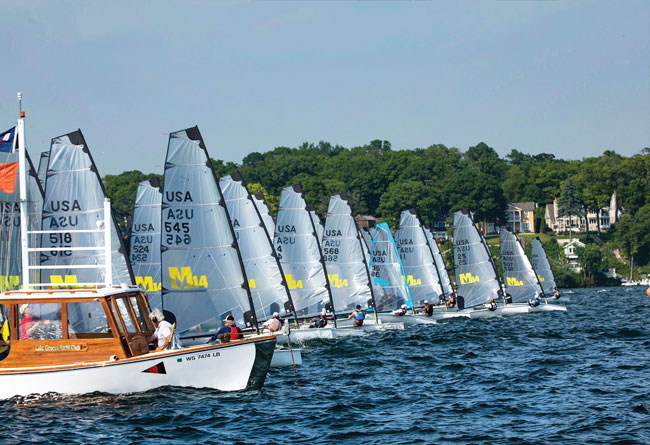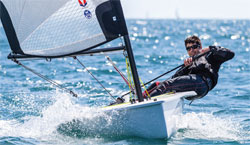

With new Melges IC37s underpinning the world champagne market at the other end of the scale the company’s little unballasted puppy is doing pretty well too...
Nearly everyone reading this will have sailed or raced a singlehanded dinghy, either as a youth, more recently as an adult, or both. The pure joy of being in complete control of your own craft speeding effortlessly across the water and the direct feedback it brings to the senses is indescribable and keeps us forever attached to this sport.
So it may come as a surprise that, with this genre being crowded with so many designs over the decades, there could still be space left for innovation – yet Melges Performance Sailboats has done just that with the Melges 14, which is now under consideration as a new Olympic singlehanded dinghy.
Similar to the excitement caused with the introduction of the Melges 24 two decades ago – a design that completely redefined the highperformance small keelboat marketplace and remains popular around the world – the Melges 14 may quite possibly do the same for all the same reasons. It takes a new and fresh approach to use of modern design tools, high-quality durable materials, fastidious fabrication standards and strict one-design class rules and management to create a brand new experience in the joy of singlehanded sailing.
Innovative design
When designing the next global singlehander for Melges, Reichel/Pugh took a fresh look at the basics, just as Bruce Kirby did with the Laser nearly 50 years ago. How could boat performance be improved while remaining practical and versatile for a wide range of users, from juniors to adults? Can this design be robust to withstand years of use and abuse and still be competitive? Will it be attractive enough to lure the interest of newcomers, but also die-hard veterans of other classes?
One look at the Melges 14 shows the results of this approach with the following features standing out right away:
- Wide hull and side decks: this feature helps not only with the stability of the boat under sail, but also makes hiking an ergonomically efficient experience for all sizes and body types, rather than an athletic torture. The beamier design with a long waterline also helps reduce the inherent size advantages that taller sailors will have on narrower boats, making sailors across a broad range of sizes competitive in the Melges 14. This feature levels the playing field.
And the extension of the wide sidedecks fore and aft allows not only for variable body positioning according to wind conditions for the singlehanders, but also encourages two-kid doublehanded fun sailing. - Open transom: this reduces weight and lets water slide out the back without the need for bailers that jam and leak. It also makes beach launching and capsize recovery easier because there are no barriers and the cockpit floor is at water level so it’s easy to climb aboard. The open transom combined with plumb bow shape also gives this design a decidedly sleek and modern look when under way.
- Excellent traction underfoot: the large cockpit has better traction than moulded non-skid due to the use of SeaDek flooring, a grippy and durable coating suitable for any footwear – or none at all.
- Simple controls and deck layout: easy but effective and reachable by a free hand on both tacks, even while hiked. The centreboard box is positioned so that it’s easy to use as a footbrace while tacking or gybing and the auto-ratcheting mainsheet block ensures proper handgrip tension in both light and heavy air. The mainsheet traveller bridle being placed forward in the cockpit means it is less prone to wrap around the back of the boat, yet it can still handle the mainsheet loads to provide proper control of mast bend.
- Carbon spars: greater strength and resilience from carbon fibre means the loads from the laminate spar are not lost in sail shape distortion. The spar’s lighter weight means less pitching and more righting moment to contribute to speed. The mast is in two pieces with a common base section and different top sections of varied stiffness appropriate for different sail sizes that are tailored to be suitable for different crew weights.
The carbon mast weighs only 4.25kg and the carbon boom weighs 2.0 kg rigged, making the rig and sail easy to handle when rigging and de-rigging. - Efficient sailplan, with multiple size options: the high-aspect ratio sail built in fibre-Mylar laminate sailcloth means light weight and durability with little shape distortion. Full-length battens preserve the sail for much longer than conventional battens, and being adjustable they can be tuned for any wind condition. Instead of a luff rope or slides, the sail has a sleeve for the carbon mast to slide in so there are no halyards to break, sail tracks to crack or fall off, or bolt ropes to wear out.
- Light weight and easy to rig and de-rig: being a mere 52kg (115 lb), the Melges 14 is easy for two people to lift on and off any car top, making for easy transport. And the simplicity of the spars, sail and control lines allows the boat to be rigged for sailing in just 15 minutes – and de-rigged quickly as well.
The Gold Rig is the full-range sail with an area of 9.1 m2, ideal for sailors in the 75kg upwards range. Plenty of power makes this setup fast and athletic, yet incredibly simple to depower.
The Blue Rig is the mid-range sail. At 7.4 m2, it’s ideal for 57kg–75kg sailors, with plenty of power for racing sailors in this size range.
The Red Rig is for smaller sailors who want to get out and enjoy the performance of the Melges 14. With a 5.46 m2 sail, the ideal weight range is 34kg–57kg.

Modern materials
Unlike most production one-designs built with inexpensive cloth, polyester resins and gelcoat materials to meet cost targets, the Melges 14 follows the long tradition of boatbuilding quality inherent to all boats built at Melges: spend more on high-quality materials and take more time to use proper fabrication techniques to do it right. The end result is a boat that is lighter, stiffer and lasts longer and hence has a greater resale value than boats built otherwise. Melges have used this philosophy for decades throughout its diverse product line of keelboats, scows and other one-designs, which in turn is reflected in the greater than average longevity of all their boats.
For the Melges 14 this starts with high-quality moulds created with CNC milling tools to exact specifications and the fabrication of strong, stable tooling of the sort you would see at production shops that build much larger boats. This is essential to ensure consistency and quality throughout production runs.
The composite engineering for the Melges 14 is also at a level you only expect to see in much larger racing boats. The lay-up process starts with an exceptional epoxy-compatible gelcoat product that leads the industry for weather resistance, high gloss finish and excellent scratch and wear resistance. Then the laminate starts with detailed specifications and use of sophisticated materials, such as biaxial and uni-directional E-glass as well as 0-90 cloth, 12mm closed cell PVC cores. Selective and detailed carbon fibre reinforcements ensure rigidity and stiffness where needed, laminated with carefully weighed and measured amounts of epoxy resin. The package is vacuumbagged to ensure full resin penetration, with no dry spots that could result in delamination. The target weight for a Melges 14 hull laminate before trimming out of the mould is only 21kg.
This approach is taken with both hull and deck, which are bonded together at the wide shear flange with a permanent rigid adhesive that keeps that joint strong and inflexible through years and years of hard use.
Build partners
To meet the worldwide demand for Melges 14s, which have so far been sold in North America, Europe, Asia, Australia and Africa, Melges has formed partnerships with three builders who share the same philosophy and technology to create boats to their exacting standards: Ovington Boats in the UK, NELO in Portugal, and Mackay Boats in New Zealand. All have had decades of experience in producing high-quality one-design racing sailboats and other craft for the recreation and performance marine market. NELO, for example, has produced 30,000 boats in the past 40 years, and is the world’s largest manufacturer of Olympic rowing skulls, with 175 employees. What has been learned from production at this volume contributes to the quality and success of the Melges 14.
Strict one-design standards and the Melges World League
One final attribute to the Melges 14 is its strong one-design heritage with sensible and adaptive class rules. The Melges brand remains strong and recognisable due to not just the boat itself and its clever design and build quality, but the integrity of class rules and a class organisation that stands behind these rules to promote fair and fun racing. It’s no wonder that some of the biggest fans of the Melges 14 are those that have already experienced years of fun in the Melges 20, 24, 32 or Scow classes, or have seen or heard about this and wanted to find out for themselves what it’s like to sail this newest member of the Melges family.
This has been made even easier with the Melges 14 having joined the Melges World League, the global racing platform and ranking system for Melges owners around the world. This clever idea in class management is designed to increase rivalry as well as camaraderie and to enhance the overall racing experience for owners and crews of Melges 20s, Melges 32s and now Melges 14s. The Melges 14 World League will feature eight championship-level regattas in its 2019 season: four in North America and four in Europe. The first ever Melges 14 World League Overall Champion, Female Champion, and North American Division Champion will be crowned at the League’s final event in the USA at Lake Lanier, Georgia next autumn. The European Division will crown its Champion in September at the Euro Cup on Lake Garda.
Click here for more information on Melges 14 »
We invite you to read on and find out for yourself why Seahorse is the most highly-rated source in the world for anyone who is serious about their racing.
To read on simply SIGN up NOW
Take advantage of our very best subscription offer or order a single copy of this issue of Seahorse.
Online at:
www.seahorse.co.uk/shop and use the code TECH20
Or for iPad simply download the Seahorse App at the iTunes store


